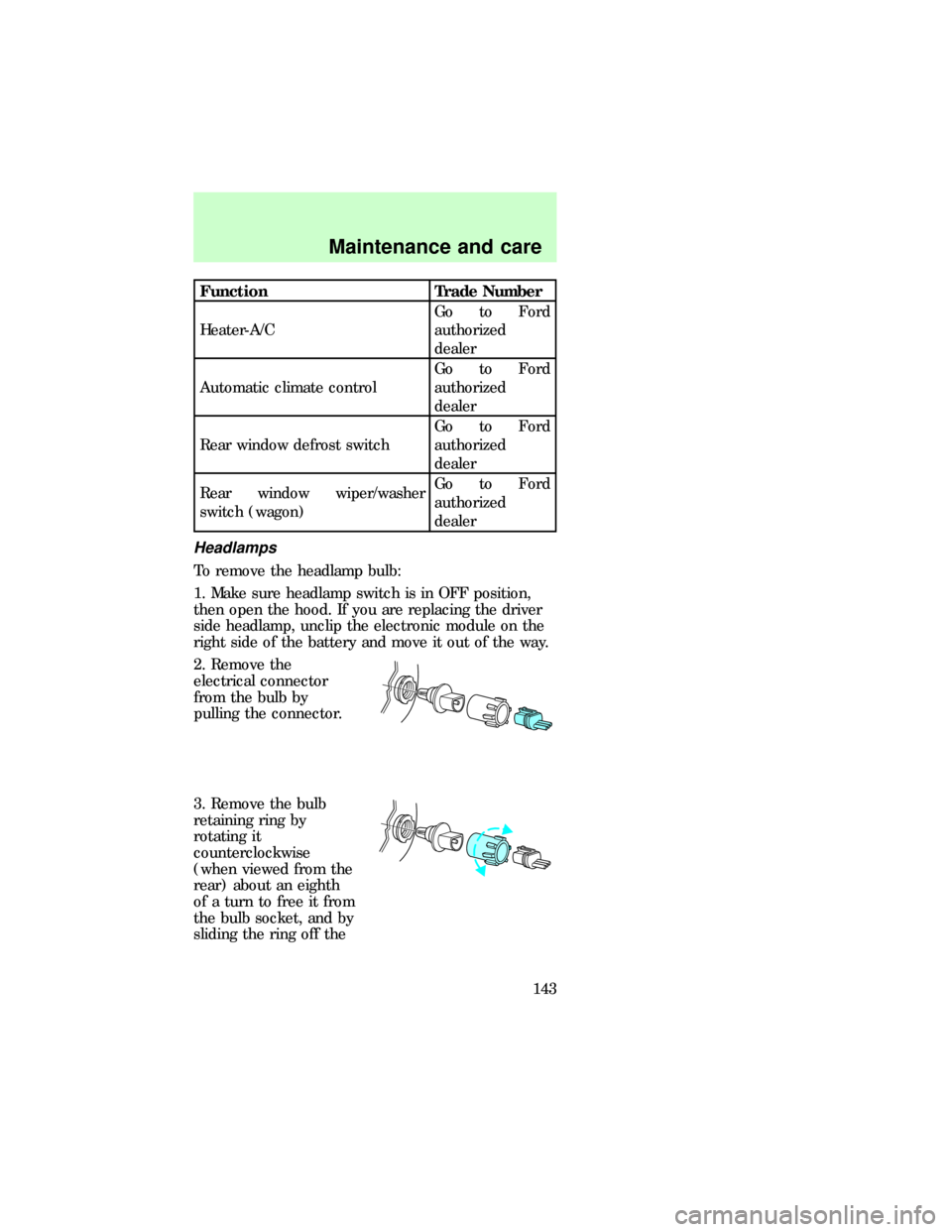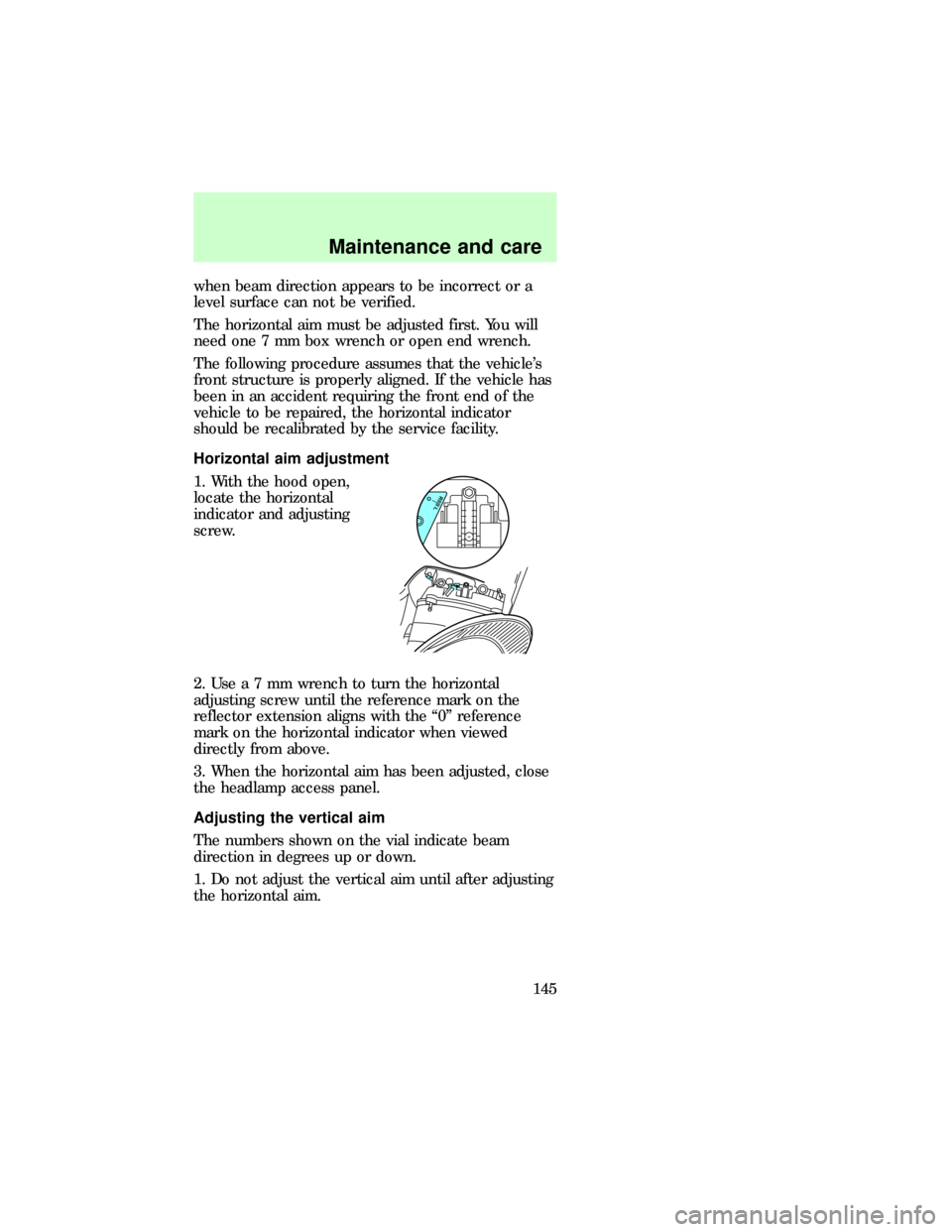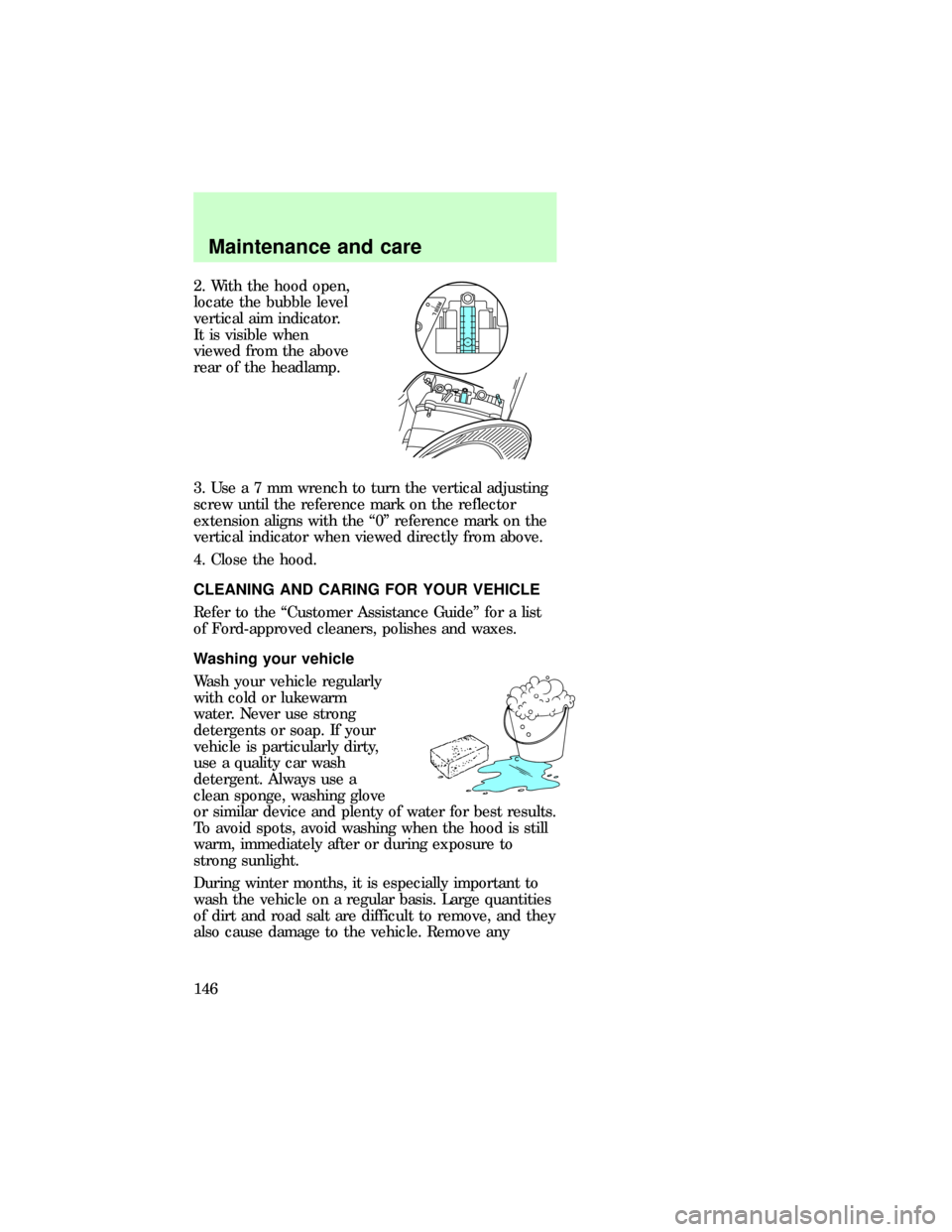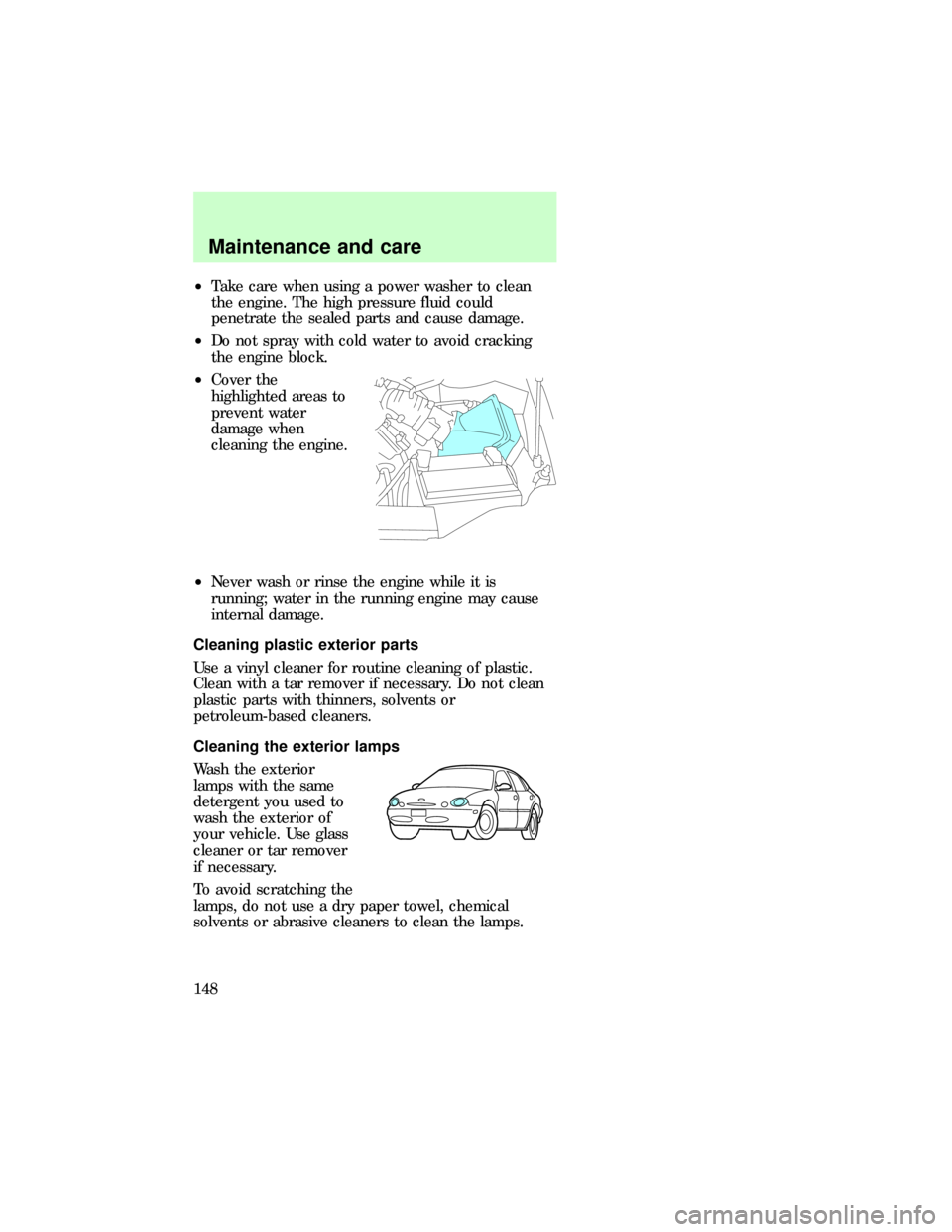Mercury Sable 1997 Owner's Manuals
Manufacturer: MERCURY, Model Year: 1997, Model line: Sable, Model: Mercury Sable 1997Pages: 167, PDF Size: 1.59 MB
Page 141 of 167

To install brake lamp:
1. Install bulbs, then position the brake lamp over
tab slots and line up the tab with the tab slots.
2. Push down and toward the rear window to engage
the tabs.
3. Push attachment toward the rear window and line
up slot in attachment with the edge of the sheet
metal screw.
4. Release the attachment slot onto the sheet metal
hole. Install the package tray trim.
High-mount brake lamp - Wagon
To remove the brake lamp:
1. Remove interior trim
panel, then remove the
three attachment nuts
that hold brake lamp in
place.
2. Lift whole assembly
off vehicle from the
outside.
3. Disconnect bulbs.
To install brake lamp:
1. Install bulbs, the position brake lamp into tailgate
holes.
2. From the inside of the vehicle, stall and tighten
the four nuts that hold the brake lamp in place.
3. Install the interior trim panel.
Using the right bulbs
Function Trade Number
Front side marker lamp 194
Front park/turn lamp 3457NA
Headlamp 9007
Tail lamp/brake lamp 3157
Maintenance and care
141
Page 142 of 167

Function Trade Number
Rear turn lamp 3156
Backup lamp 3156
License plate lamp 168
High-mount brake lamp 912
Rear side marker lamp 168
Cargo lamp (wagon) 211-2
Dome lamp 211-2
Dome/map lamp 578
Dome lamp/moon roof 208
Visor vanity lamp
(passenger/driver)74-194
Door courtesy lamp 168
Floor console 194
Luggage compartment lamp 906
Glove compartment 194
Instrument courtesy lamps 168
I/P ashtray lamp 194
Radio illuminationGo to Ford
authorized radio
service center
ClockGo to Ford
authorized
dealer
Warning indicator lights (except
THEFT)Go to Ford
authorized
dealer
THEFT warningGo to Ford
authorized
dealer
Cluster illuminationGo to Ford
authorized
dealer
Maintenance and care
142
Page 143 of 167

Function Trade Number
Heater-A/CGo to Ford
authorized
dealer
Automatic climate controlGo to Ford
authorized
dealer
Rear window defrost switchGo to Ford
authorized
dealer
Rear window wiper/washer
switch (wagon)Go to Ford
authorized
dealer
Headlamps
To remove the headlamp bulb:
1. Make sure headlamp switch is in OFF position,
then open the hood. If you are replacing the driver
side headlamp, unclip the electronic module on the
right side of the battery and move it out of the way.
2. Remove the
electrical connector
from the bulb by
pulling the connector.
3. Remove the bulb
retaining ring by
rotating it
counterclockwise
(when viewed from the
rear) about an eighth
of a turn to free it from
the bulb socket, and by
sliding the ring off the
Maintenance and care
143
Page 144 of 167

plastic base. Keep the ring because it will be used
again to retain the new bulb.
4. Remove the old bulb from its socket by gently
pulling it straight back out of the socket. Do not
turn the bulb while you are removing it.
To install the new bulb:
1. With the flat side of
the bulb's plastic base
facing upward, insert
glass end of the bulb
into the socket. You
may need to turn the
bulb left or right to line
up the grooves in the
plastic base with the
tabs in the socket. When the grooves are aligned,
push the bulb into the socket until the plastic base
contacts the rear of the socket.
2. Slip the bulb retaining ring over the plastic base
until it contacts the rear of the socket by rotating it
clockwise until you feel a ªstop.º
3. Push the electrical connector into the rear of the
plastic base until it snaps, locking it into position.
4. Turn the headlamps on and make sure they work
properly. If the headlamp was correctly aligned
before you changed the bulb, you should not need to
align it again.
AIMING THE HEADLAMPS
Your vehicle is equipped with a Vehicle Headlamp
Aim Device (VHAD) on each headlamp body. Each
headlamp may be proeprly aimed in the horizontal
direction (left/right) and the vertical position
(up/down).
A non-zero bubble reading does not necessarily
indicate out-of-aim headlamps. If your vehicle is not
positioned on a level surface, the slope will be
included in the level indicator. Therefore, vertical
headlamp adjustment should be performed only
dno_formality
Maintenance and care
144
Page 145 of 167

when beam direction appears to be incorrect or a
level surface can not be verified.
The horizontal aim must be adjusted first. You will
need one 7 mm box wrench or open end wrench.
The following procedure assumes that the vehicle's
front structure is properly aligned. If the vehicle has
been in an accident requiring the front end of the
vehicle to be repaired, the horizontal indicator
should be recalibrated by the service facility.
Horizontal aim adjustment
1. With the hood open,
locate the horizontal
indicator and adjusting
screw.
2.Usea7mmwrench to turn the horizontal
adjusting screw until the reference mark on the
reflector extension aligns with the ª0º reference
mark on the horizontal indicator when viewed
directly from above.
3. When the horizontal aim has been adjusted, close
the headlamp access panel.
Adjusting the vertical aim
The numbers shown on the vial indicate beam
direction in degrees up or down.
1. Do not adjust the vertical aim until after adjusting
the horizontal aim.
R L
O
dno_aiming-headlamps
dno_aiming
Maintenance and care
145
Page 146 of 167

2. With the hood open,
locate the bubble level
vertical aim indicator.
It is visible when
viewed from the above
rear of the headlamp.
3.Usea7mmwrench to turn the vertical adjusting
screw until the reference mark on the reflector
extension aligns with the ª0º reference mark on the
vertical indicator when viewed directly from above.
4. Close the hood.
CLEANING AND CARING FOR YOUR VEHICLE
Refer to the ªCustomer Assistance Guideº for a list
of Ford-approved cleaners, polishes and waxes.
Washing your vehicle
Wash your vehicle regularly
with cold or lukewarm
water. Never use strong
detergents or soap. If your
vehicle is particularly dirty,
use a quality car wash
detergent. Always use a
clean sponge, washing glove
or similar device and plenty of water for best results.
To avoid spots, avoid washing when the hood is still
warm, immediately after or during exposure to
strong sunlight.
During winter months, it is especially important to
wash the vehicle on a regular basis. Large quantities
of dirt and road salt are difficult to remove, and they
also cause damage to the vehicle. Remove anyR L
O
com_cleaning_caring.01
com_washing_vehicle.01
Maintenance and care
146
Page 147 of 167

exterior accessories, such as antennas, before
entering a car wash.
²After washing, apply the brakes several times to
dry them.
Waxing your vehicle
The best way to determine when the paintwork
needs waxing is by noting when water stops beading
on the surface. This could be every three or four
months, depending on operating conditions.
Use only carnauba or synthetic-based waxes.
Remove any bugs and tar before waxing vehicle. Use
cleaning fluid or alcohol with a clean cloth to
remove. Use tar remover to remove any tar spots.
Repairing paint chips
Minor scratches or paint damage from road debris
may be repaired with touch-up paint, paint repair
foil or aerosol paint spray from the Ford accessory
line. Observe the application instructions on the
products.
Remove particles such as bird droppings, tree sap,
insect remains, tar spots, road salt and industrial
fallout immediately.
Cleaning the wheels
Wash the wheels with
the same detergent you
use to clean the body
of your vehicle. Do not
use acid-based wheel cleaners, steel wool, fuel or
strong detergents. Never use abrasives that will
damage the finish of special wheel surfaces. Use a
tar remover to remove grease and tar.
Cleaning the engine
Engines are more efficient when they are clean
because grease and dirt buildup act as insulators and
keep the engine warmer than normal. Follow these
guidelines to clean your engine:
com_waxing_vehicle.01
com_repairing_chips
com_wheels_cleaning.01
com_engine_cleaning.01
Maintenance and care
147
Page 148 of 167

²Take care when using a power washer to clean
the engine. The high pressure fluid could
penetrate the sealed parts and cause damage.
²Do not spray with cold water to avoid cracking
the engine block.
²Cover the
highlighted areas to
prevent water
damage when
cleaning the engine.
²Never wash or rinse the engine while it is
running; water in the running engine may cause
internal damage.
Cleaning plastic exterior parts
Use a vinyl cleaner for routine cleaning of plastic.
Clean with a tar remover if necessary. Do not clean
plastic parts with thinners, solvents or
petroleum-based cleaners.
Cleaning the exterior lamps
Wash the exterior
lamps with the same
detergent you used to
wash the exterior of
your vehicle. Use glass
cleaner or tar remover
if necessary.
To avoid scratching the
lamps, do not use a dry paper towel, chemical
solvents or abrasive cleaners to clean the lamps.
com_plastic_exterior.01
com_exterior_lamps.01
com_wiper_cleaning.01
Maintenance and care
148
Page 149 of 167

Cleaning the wiper blades
If the wiper blades do
not wipe properly,
clean both the
windshield and wiper
blades using undiluted
windshield wiper
solution or a mild
detergent. Rinse
thoroughly with clean
water. To avoid
damaging the blades,
do not use fuel,
kerosene, paint thinner
or other solvents.
Cleaning the instrument panel
Clean instrument panel with a damp cloth, then dry
with a dry cloth.
Any cleaner or polish that increases the gloss of the
upper portion of the instrument panel should be
avoided. The dull finish in this area is to help
protect the driver from undesirable windshield
reflection.
Cleaning the interior fabric
Remove dust and loose dirt with a whisk broom or a
vacuum cleaner. Remove fresh spots immediately.
Follow the directions that come with the cleaner.
BASSTREBBALFADEREWFFEJECT1234
56wTAPE SIDETAPE
R-DEFTUNESEEKSCAN AM
FMMH
LO
HIOFF
A/C
MAX
A/CVENTVOL
PUSH-ONwSTFM 12
AMCBLRFEFC HFUEL DOOR>SERVICE
ENGINE
SOONLOW
COOLANTTHEFT102030405060
70
80
90
100
1202060100
140
180P R N D 2 1MPH km/h0000000000P!
BRAKE+ –110CRUISERPMx1000ABSO/D
OFFREAR
LAMP
OUTPREMIUM UNLEADED
FUEL RECOMMENDED0 1234
5
6
78
com_instru-panel_cleaning.01
com_int_fabric_cleaning.01
com_leather_seats_cleaning.01
Maintenance and care
149
Page 150 of 167

Cleaning leather seats (if equipped)
For routine cleaning, wipe the surface with a soft,
damp cloth. For more thorough cleaning, wipe the
surface with a leather and vinyl cleaner or a mild
soap.
Cleaning and maintaining the safety belts
Clean the safety belts with a mild soap solution
recommended for cleaning upholstery or carpets. Do
not bleach or dye the belts, because these actions
may weaken the belt webbing.
Check the safety belt system periodically to make
sure there are no nicks, wear or cuts. If your vehicle
has been involved in an accident, have all the safety
restraints examined by a qualified technician.
Cleaning the built-in child seat (if equipped)
Clean the built-in child seat with mild soap and
water. Do not use household cleaning products
because they may weaken the safety belt webbing or
damage the vinyl parts of the seat.
The child seat liner is removable and may be
machine-washed and air dried.
com_safety_belts_cleaning.01
com_child-seat_cleaning.01
Maintenance and care
150